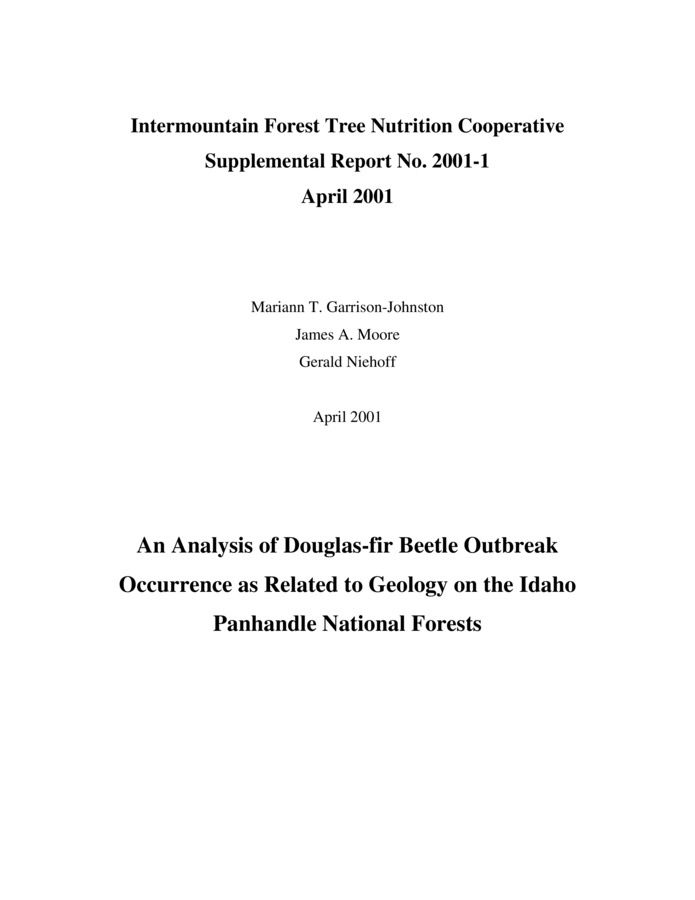PDF
An Analysis of Douglas-fir Beetle Outbreak Occurrence as Related to Geology on the Idaho Panhandle National Forests Item Info
- Title:
- An Analysis of Douglas-fir Beetle Outbreak Occurrence as Related to Geology on the Idaho Panhandle National Forests
- Creator:
- Garrison-Johnston, M.T.; Moore, J.A.; Niehoff, G.
- Date Created (ISO Standard):
- 2001-04-01
- Approximated Date:
- yes
- Description:
- Douglas-fir (Pseudotsuga menziesii) is a native conifer species which is widely distributed throughout the inland northwest of the United States. This species occurs across a variety of site conditions, and may grow in pure stands or in combination with other tree species common to the area. Douglas-fir is one of the most important timber-producing species in the region. A number of insects and diseases affect Douglas-fir stands in the region. Most are endemic to the area and experience natural cycles of buildup and decline. During the late 1990's, an endemic insect known as the Douglas-fir beetle (Dendroctonus pseudotsugae Hopkins) began to increase to epidemic proportions throughout much of northern Idaho and northeastern Washington. This beetle burrows into the tree's bark and lays eggs. The adults and larvae then feed on the phloem, usually girdling and killing the tree (Hagle et al. 1987). During 1996 and 1997, an average of 51 ha/yr (125 ac) were affected by new Douglas-fir beetle attacks. By 1998 approximately 479 ha (1185 ac) were affected, and in 1999, aerial surveys indicated that 31,093 ha (76,830 ac) were impacted. These outbreaks caused great concern, due largely to the increased fire danger caused by huge areas of dead timber. Furthermore, as populations built, the beetles were able to spread further and faster than normal, affecting both public and private timberland in the region. The Panhandle National Forests initiated emergency salvage logging operations in the region, both to reduce fire risk and to reduce the risk of beetles spreading to adjacent private lands. Recent findings in forest health research have indicated that the bedrock geology underlying forest stands may play an important role in forest nutrition, and consequently may affect tree susceptibility to insects and disease. While direct relationships between rocks and forest stand health have not yet been established, we believe that such relationships exist. In the current study, Forest Service workers in north Idaho and northeastern Washington noted a tendency for Douglas-fir beetle outbreaks to occur more frequently on certain rock types than others, even though adjacent stands on other rock types seemed otherwise very similar. This analysis utilizes Forest Service data on forest vegetative cover and Douglas-fir beetle distribution in combination with geologic data to assess whether beetles favored stands on certain rock types.
- Subjects:
- research (document genres) fire prevention forest management timber (lumber) wood borers (beetles) geological maps
- Location:
- North and Central Idaho; Eastern Washington; Western Montana; Northeastern Oregon
- Publisher:
- Intermountain Forest Tree Nutrition Cooperative, University of Idaho, College of Forest, Wildlife and Range Sciences, Moscow
- Source:
- Garrison-Johnston, M.T., J.A. Moore, and G.J. Niehoff. 2001. An Analysis of Douglas-fir Beetle Outbreak Occurrence as Related to Geology on the Idaho Panhandle National Forests. IFTNC Supplemental Report No. 1. IFTNC College of Natural Resources, Univ. of Idaho, Moscow.
- Source Identifier:
- Analysis_of_DF_Beetle_Outbreak_Occurrence_Related_to_Geology_on_the_Idaho_Panhandle_National_Forests_IFTNC_2001
- Type:
- Text
- Format:
- application/pdf
- Language:
- eng
Source
- Preferred Citation:
- "An Analysis of Douglas-fir Beetle Outbreak Occurrence as Related to Geology on the Idaho Panhandle National Forests", Idaho Forestry Research Collection, University of Idaho Library Digital Collections, https://www.lib.uidaho.edu/digital/forestryresearch/items/forestryresearch928.html
Rights
- Rights:
- In copyright, educational use permitted. Educational use includes non-commercial reproduction of text and images in materials for teaching and research purposes. For other contexts beyond fair use, including digital reproduction, please contact the University of Idaho Library Special Collections and Archives Department at libspec@uidaho.edu. The University of Idaho Library is not liable for any violations of the law by users.
- Standardized Rights:
- http://rightsstatements.org/vocab/InC-EDU/1.0/

